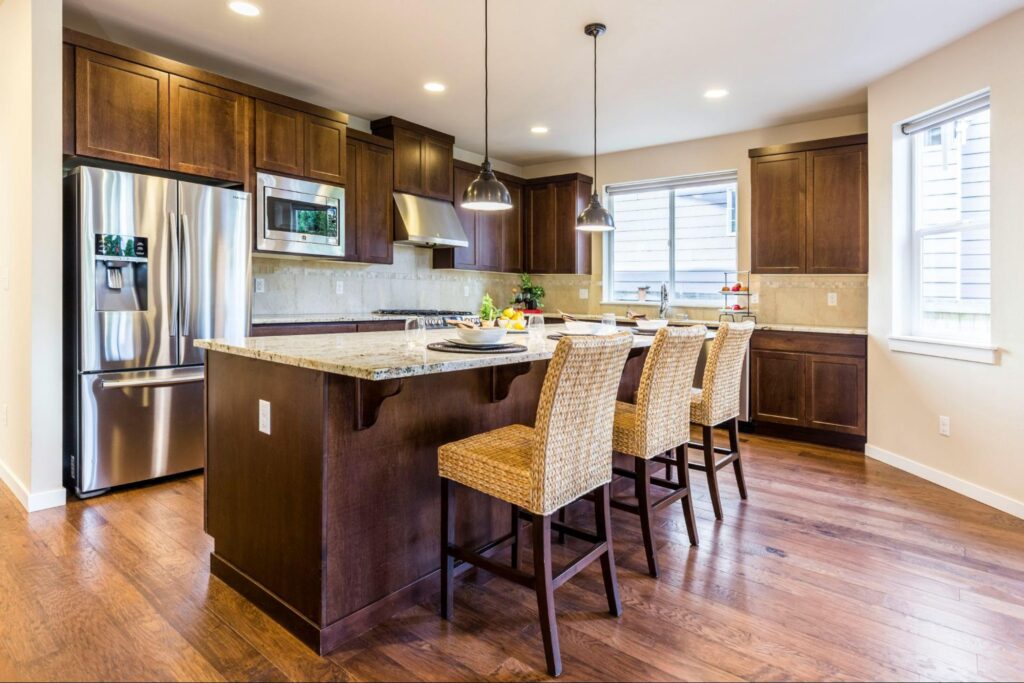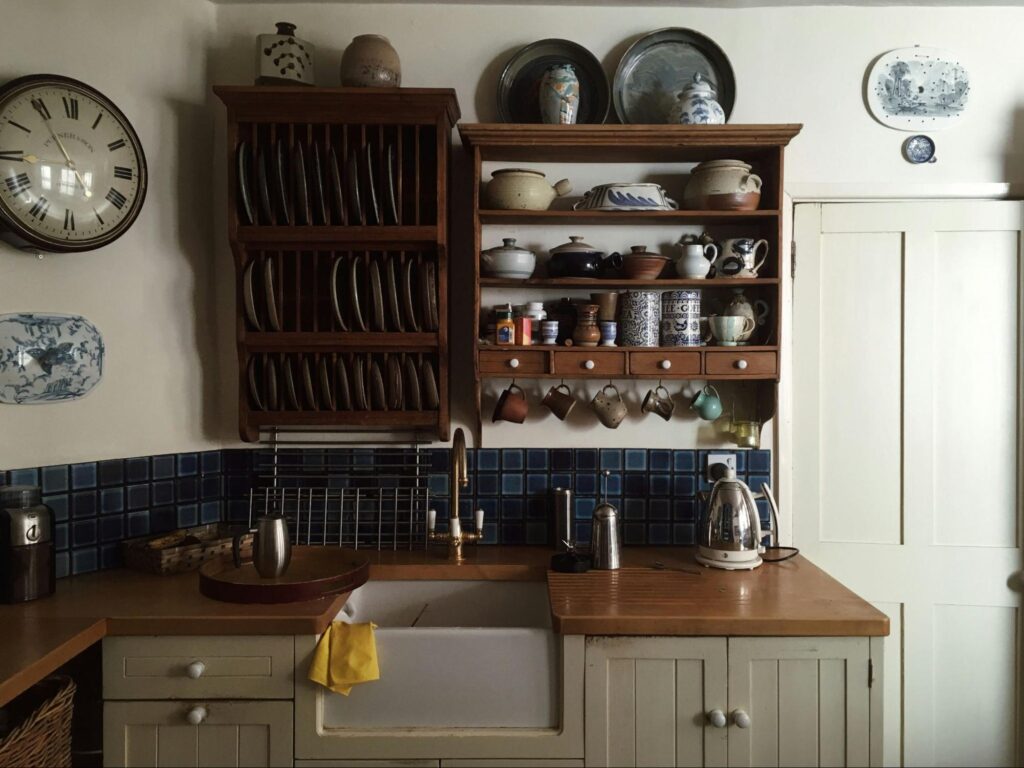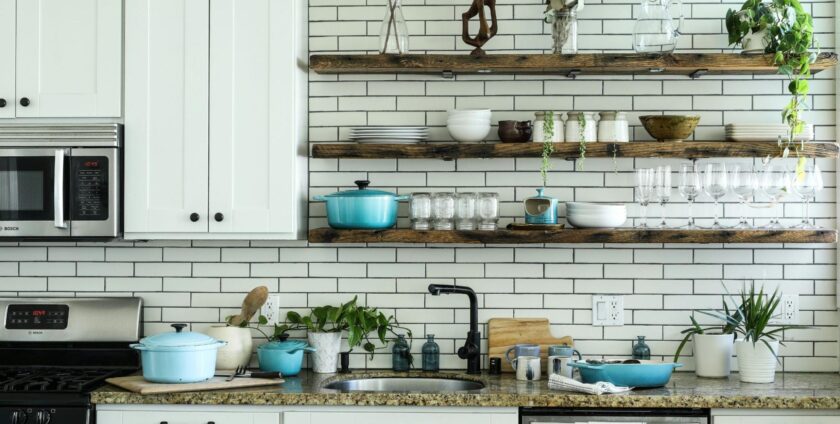
The kitchen is the heart of the home – this is a very common saying.
Kitchen renovation can be quite intimidating. From the planning, through the time-consuming design and layout, construction, and the end of the renovation – kitchen remodels are stressful. They involve a significant change in lifestyle and habits.
Considering all you have to do in the kitchen when doing a renovation, this type of remodel is one of the most expensive ones you can tackle. Sometimes the budget is what decides all the design choices.
There are a significant number of styles you can choose from. Here we have gathered some of the most interesting ones, so you can make that decision easier.
6 Styles to Consider for Your Kitchen
In the world of interior design there are lots of trends. Some are timeless, and others have a very short life expectancy. That’s why it’s really important to consider the design of any space in details before you go forward with a renovation.
When you plan a kitchen remodel, there are two important moments – 1. How to make the space as efficient as possible, and 2. how to include your favourite design elements.
If the kitchen remodel is part of a bigger project, then you can easily change the design in every space of your home. But if you only plan on renovating the kitchen, then you have to consider the overall design choices in your home to fit the space.
Here, we are going to take a look at some of the most preferred styles for kitchens.
The Modern Kitchen
Source: Unsplash
Modern kitchens are sleek, clean and monochrome. They leave a sense of peace and cleanliness like no other space.
This type of interior design for the kitchen has some key elements such as:
- A monochromatic look
- Geometric lines of the kitchen cabinets and furniture
- Stainless steel appliances
- Clean and uncluttered space.
This type of design often includes the use of natural stone, concrete and tiles for the countertops, backsplash and other areas in the kitchen. These combined with stainless steel elements all contribute to the overall modern look of the space.
The Traditional Kitchen
Source: Unsplash
In the past years, the traditional style kitchen has been a style on the rise with homeowners. In this type of space, you can add a lot of personal touch and preference.
Traditional kitchens have the following elements:
- Rustic-looking wood or stone flooring
- Real wood cabinets and countertops
- A lot of storage space
- Fun and whimsical details.
The options with a traditional kitchen are so many, that you can easily get lost in all the design choices. Most homeowners combine the traditional kitchen design with some modern elements to make it more up-to date with day-to-day life.
The English Kitchen
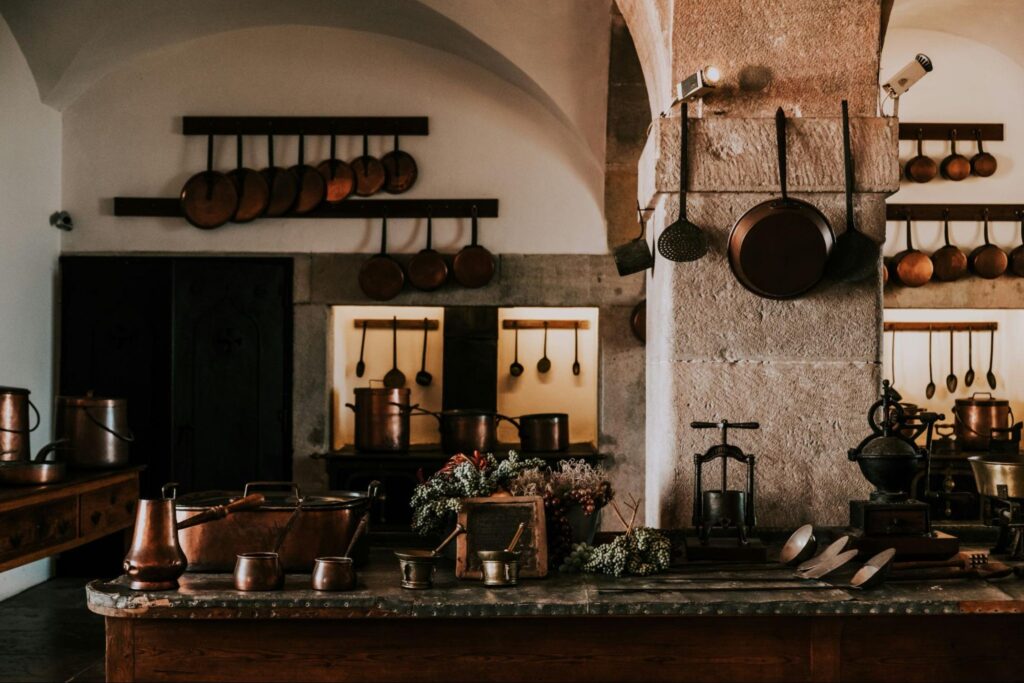
This style refers to traditional English design. The English kitchen has a lot of charm but is also very practical. It has a lot of storage space and a timeless elegance that combines well with both contemporary and classic interior design.
The key elements of the English kitchen are:
- Shaker-style cabinets and cupboard doors
- Natural materials like wood, stone and ceramics
- Wooden work surfaces
- Earthy colour palette
- Large and deep sink
In the English-style kitchen, you can easily incorporate your personal style preferences.
The Industrial Kitchen
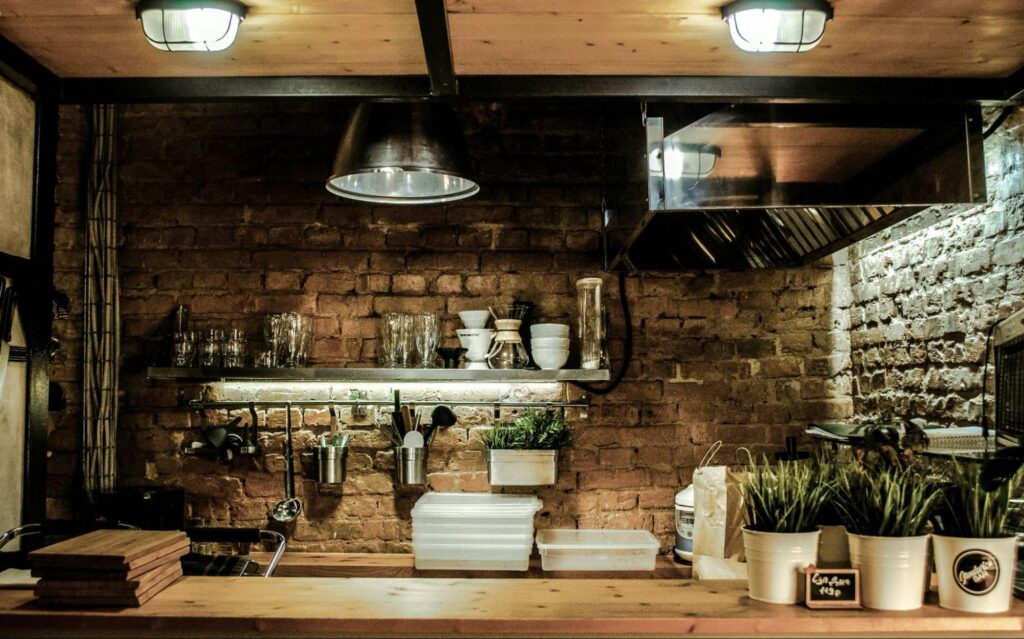
The industrial design trend has been on the rise since its emergence in the 60s and 70s. This type of kitchen is practical and has a lot of storage.
The main elements of an industrial design kitchen are:
- Stainless steel everything – from the cabinets to the countertops.
- Open shelving
- Using pipes as a design or structural element
- Concrete flooring and countertops
- Utility over charm.
Oftentimes, industrial design kitchen has a very neutral colour palette typical for big factories – black, grey and with wooden accents. Sometimes you will see a very bright design element, typically in red or yellow.
The Scandinavian Kitchen
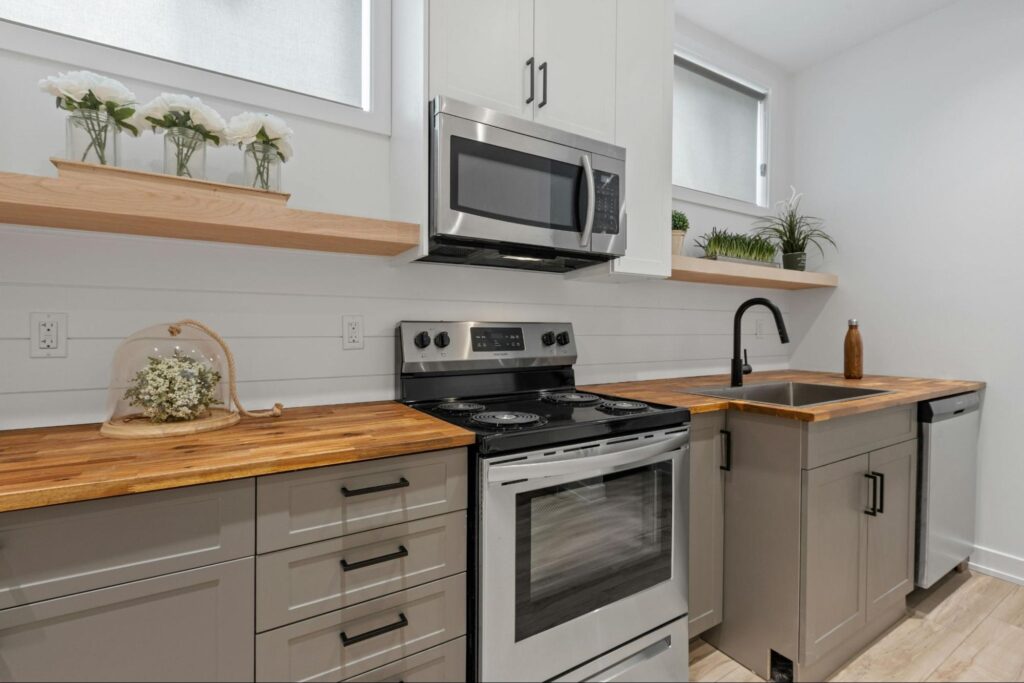
Scandinavian design overall has been on the rise in recent years. More and more people seem to embrace the notions of less is more and quality over quantity – both very popular in Scandinavian countries. This also applies to the kitchen style.
The main elements of a Scandinavian kitchen are:
- Clean and bright colour palette
- Wooden countertops for a touch of natural feel
- Wood flooring
- Modern wood cabinets
- Modern appliances.
The overall feel of the Scandinavian kitchen is light and airy. There’s a lot of natural light, oftentimes from big windows in the space. The kitchen looks sleek but, at the same time, cosy, thanks to kitchen decor.
The Cottage Kitchen
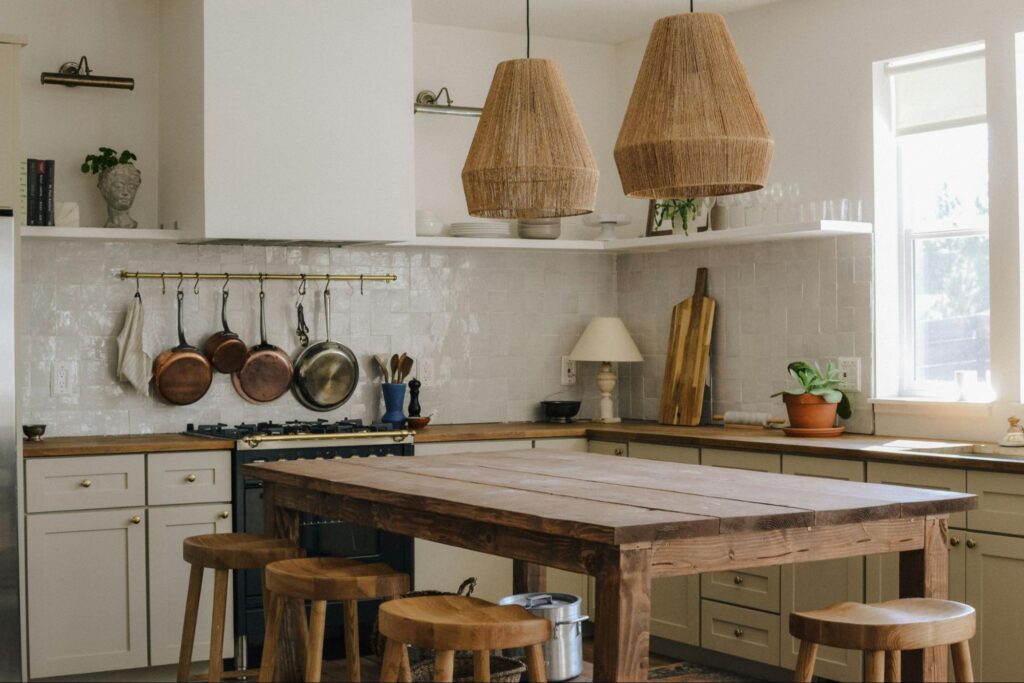
The cottage kitchen is probably the style that directly evokes the phrase “The kitchen is the heart of the home”. This style is very cozy, filled with interesting and eclectic accessories. It also leaves a sense that space has been lived in.
The main elements of the cottage kitchen are:
- Natural materials – lots of wood, stone and ceramics
- Big ceramic or metal sinks
- Wooden cabinets with vintage elements
- Colourful tiles.
- Open shelving and storage.
Oftentimes you can see vintage elements in this type of kitchen style. Homeowners add old tables, chairs and accessories to the space to make it look more lived in rather than sleek and cold. Overall, the cottage kitchen feels very warm and inviting.
6 Ideas for Choosing a Kitchen Layout Design
The layout design of your kitchen depends on two things – 1. How much space you have and 2. how to make the space as usable as possible.
Some homeowners prefer to have more space to move around the kitchen, while others want everything at arm’s length.
The most essential utilities in every kitchen are the fridge, the sink and the stove. Using these three, it’s a good rule to try to form a triangle in the space so you can move quickly and functionally through the space.
Here, we are going to take a look at some kitchen layout ideas and their pros and cons.
U-Shaped
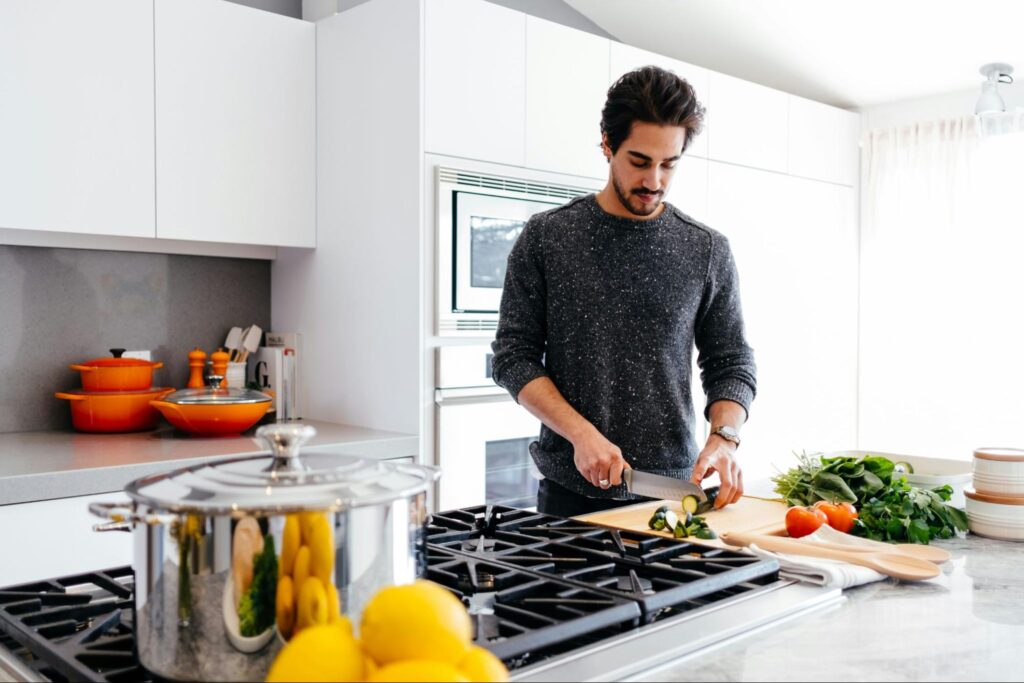
A U-shaped kitchen is a space where the cabinets form a U against the walls. That means all three adjoining walls have cabinets.
The pros of this design are:
- Better workflow within the space
- A lot of counter space
- Multiple storage options
- Flexible design – it works well both in open plan space and in a separate room.
- Clearly defines the kitchen space.
The cons of this design are:
- Leaves a feeling of being closed off. The corners of the counters are typically out of reach.
- It’s not okay for small rooms.
- Leaves no room for a dining table and chairs.
- It’s not ideal for more than one person to work in.
One way to make the U-shaped kitchen airier is to use more neutral light colours.
Peninsula
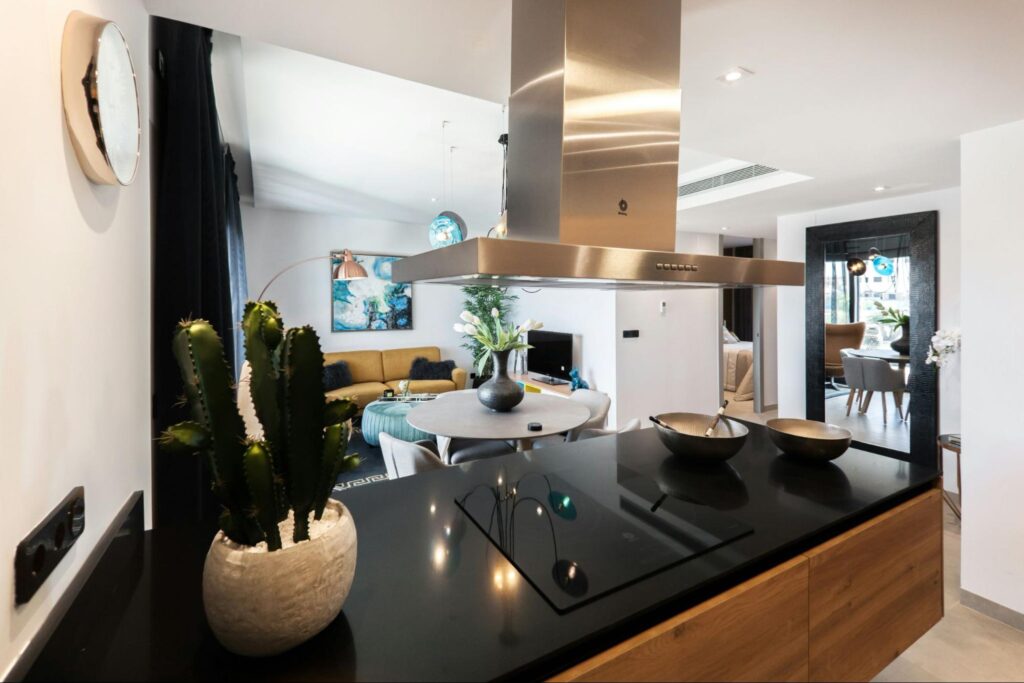
The Peninsula is a kitchen layout where the countertops and cabinetry extend into the space and thus create a smaller enclosed space.
The pros of this kitchen are:
- You have even more workspace.
- It’s ideal for small spaces where an island can’t be placed.
- More storage
- Better flow in the kitchen area
- It can serve as an extra dining room.
The cons of this kitchen are:
- Limited access – the peninsula-shaped kitchen isn’t accessible from all sides.
- Leaves a closed-off feeling.
- Limits how many people can dine at once, especially if you don’t have any other dining space.
- It’s not a flexible design – you can’t easily move the cabinetry around.
A Peninsula kitchen can be considered a classic option, but it can be achieved in a room with more space.
One-Wall
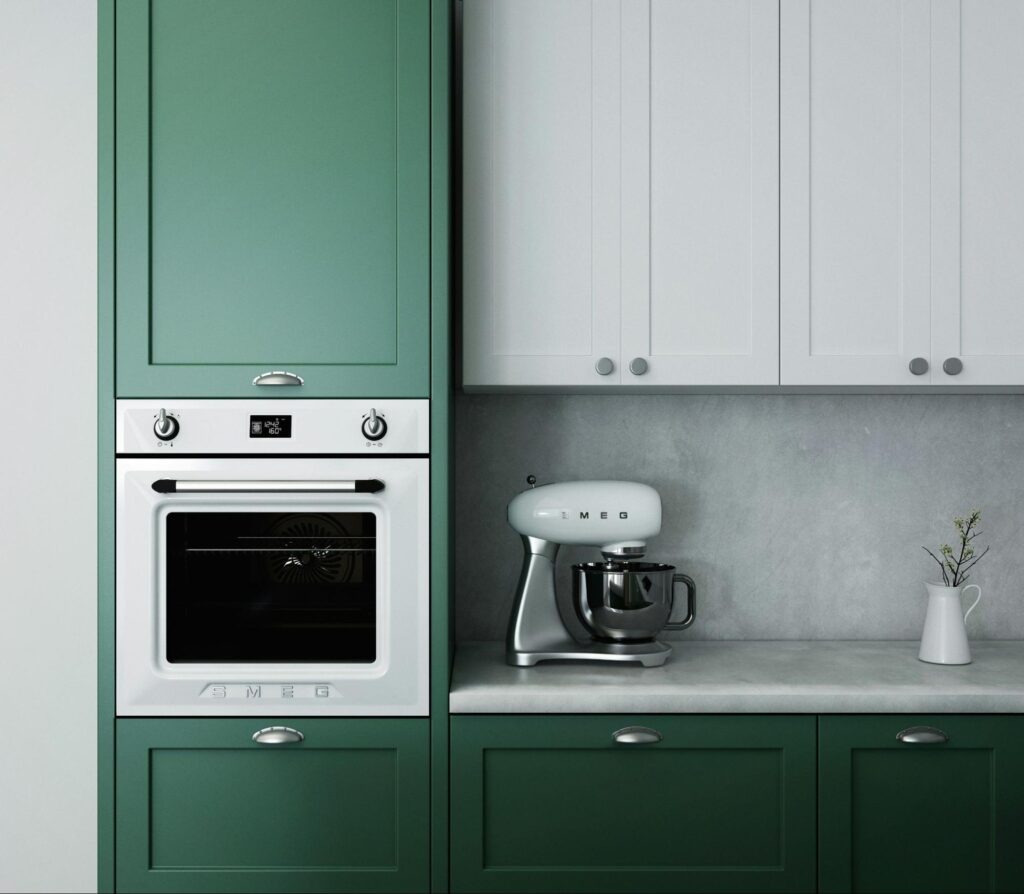
The one wall kitchen is perfect for small living spaces. They are ideal for open-plan living as they feel light and airy. Here, all the cabinetry and appliances are on a single wall in the room.
The pros of a one-wall kitchen are:
- Cost-effectiveness – this type of kitchen layout is cheaper because you have fewer cabinets.
- Open-plan kitchen layouts
- Streamlined workflow
- Easier to maintain.
The cons are:
- Less storage space
- Less countertop space
- The workflow is less efficient as everything is in one line.
One way to have more storage in a single-wall kitchen is to extend the wall cupboards all the way up to the ceiling.
L-Shaped
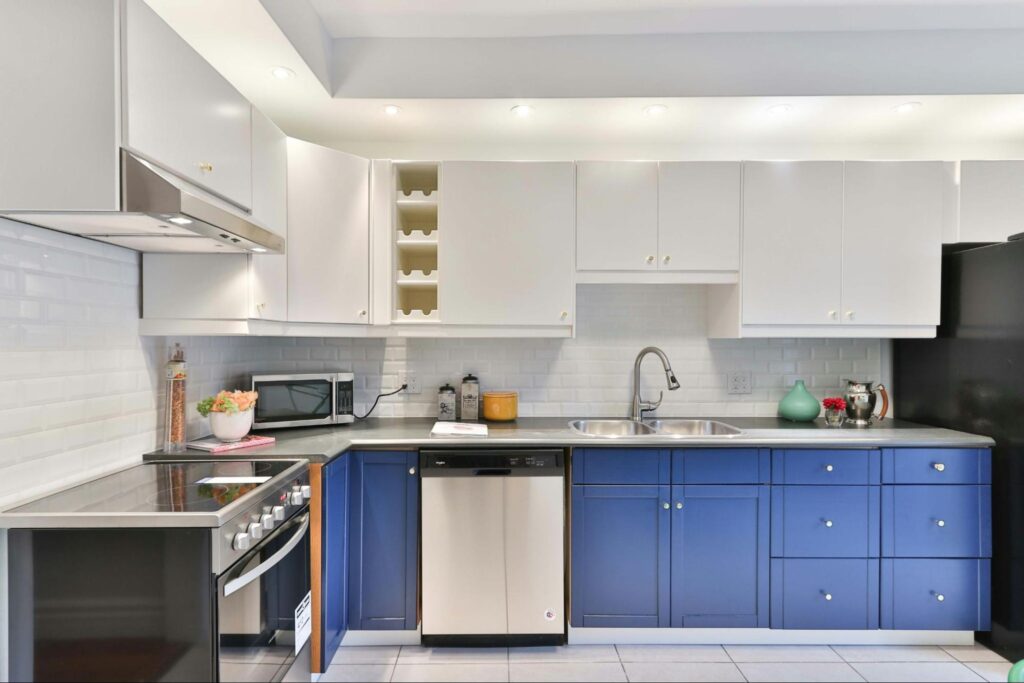
The L-shaped design is really preferred in modern times because it combines efficiency with saving space in the room. It’s ideal both for small and large rooms.
The pros of the L-shaped kitchen are:
- Better workflow of the space
- Open space layout
- More counter space and storage
- Leaves room for additions and changes in the future.
The cons of this kitchen are:
- Doesn’t work well in large kitchens
- All appliances have to be placed well to be easily usable.
- Storage problems may arise.
- The good thing about L-shaped kitchens is that they can be easily upgraded with a working table or a kitchen island.
Island
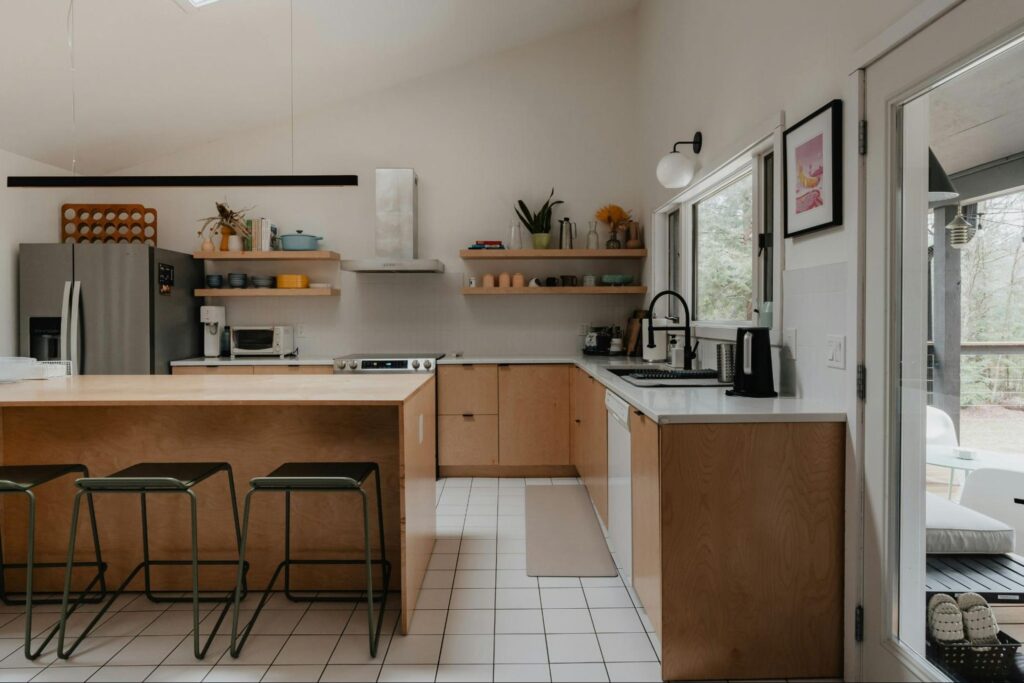
The island kitchen has been around for decades, and it’s easy to see why. Having an island can serve as additional storage, or you can add bar stools for dining. It gives you more counterspace. You can even incorporate your sink into the island to make the workflow better.
The pros of the island kitchen layout are:
- More workspace and storage
- Creates a social zone in the kitchen
- It can be extremely versatile.
- Drastically improves workflow.
The cons of this layout are:
- You need a lot of space in the room.
- The cost is a lot higher when adding an island.
- The island can easily become cluttered.
- It reduces accessibility to the main working kitchen space.
You can avoid some of the problems if you have a movable island – like a table or a cart on wheels. That way, you can easily change the flow of the space.
Galley
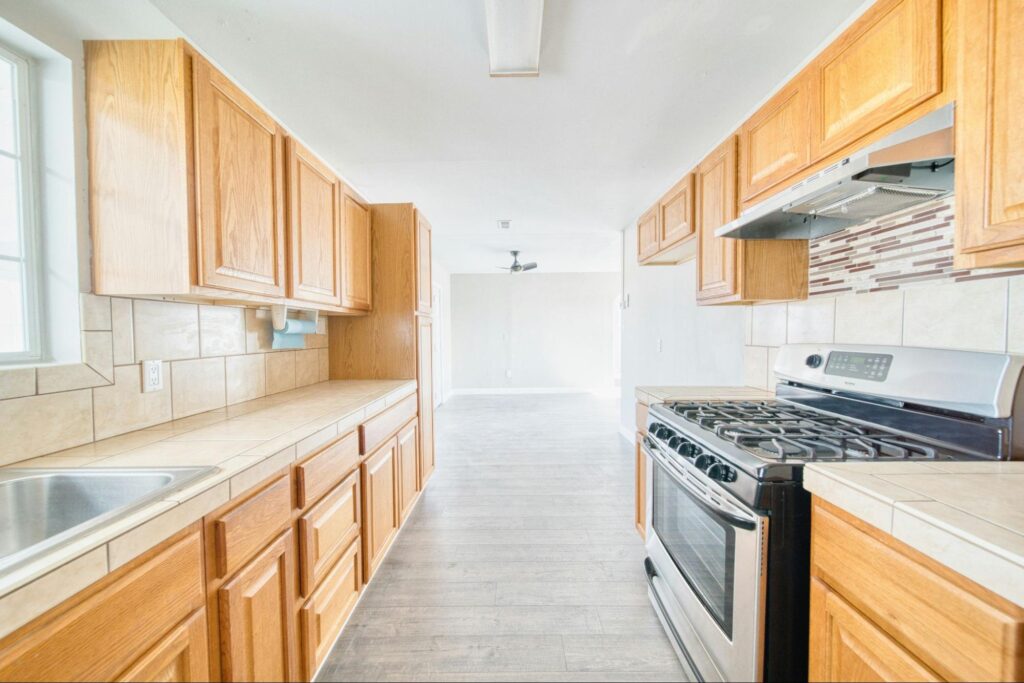
A small galley kitchen can look really cosy and is perfect for small living spaces. In this type of kitchen, all appliances and cabinetry are on two parallel walls, creating a walkway between them. It’s often called a corridor kitchen.
The pros of a galley kitchen are:
- Good workflow
- Maximises space
- Cost-effective
- Very good for cooking
- It’s a flexible design that is good for both small and large homes.
- It offers privacy.
The cons of a galley kitchen are:
- It may feel cramped and limiting.
- Lack of social interaction
- Limits natural lighting.
- Limited storage and countertop space.
One way to make a galley kitchen look airier is to use open shelving on one of the walls. Also, when choosing a colour scheme for the space, make sure you choose light colours in pastel tones.
What to Consider When It Comes to the Kitchen Size?
Homeowner choices when it comes to kitchen remodelling are oftentimes restricted by the space they have to work with. Sometimes, space defines the end design of the kitchen.
Here are the main things to consider if you have a small or a large kitchen.
Small Kitchens
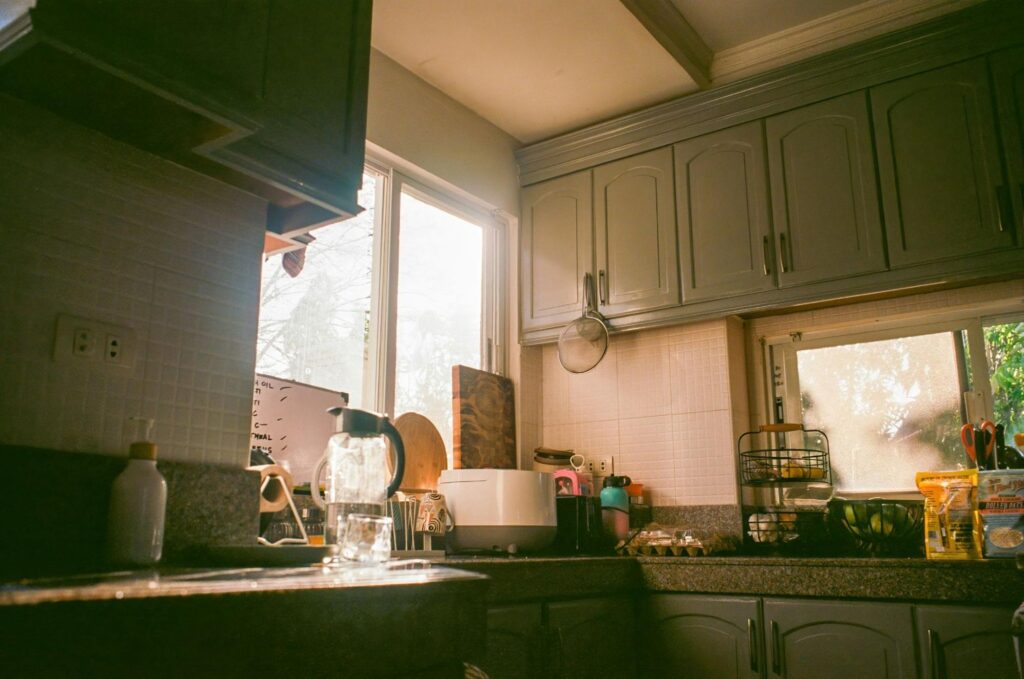
Small kitchens can be really hard to work with if you don’t have a plan beforehand. Oftentimes, the restricted space may leave a feeling that you don’t have options for any design features.
Storage space
The main thing you need to consider is how to organise the space and have enough storage.
When choosing cabinets for a small kitchen, a good way to optimise the space is by adding storage all the way up to the ceiling. That way, the kitchen will have ample storage, and the countertops will be free to work without any unnecessary appliances.
Countertop space
The countertops are the main working spaces in the kitchen. When you have a small room, having enough countertop space can be challenging.
You can influence that by clever placement of all the needed appliances. That way, you can have enough counter space without sacrificing the flow of the room. Also, adding open shelving or other additional storage solutions can reduce clutter and add aesthetic appeal to the space.
Colour Palette
Small kitchens can feel cramped. Choosing the right colour palette can make the space feel bigger.
This doesn’t mean you have to stay away from bold colours like black, dark green, dark blue, etc. Instead, choose the colour you prefer for your overall design feel and design a monochromatic colour palette with different shades of the same colour. And as always, you can go with an all white kitchen, if that’s your preference.
Workflow
Small kitchens can feel really restraining, and that can affect the space’s workflow. When deciding on where to place your appliances, remember the rule of the triangle – the sink, the fridge, and the stove have to form an invisible triangle. That way, you achieve a better workflow when you prep and cook meals.
Also, more storage means that your space will be less cluttered. That can also positively influence the workflow.
Large Kitchens
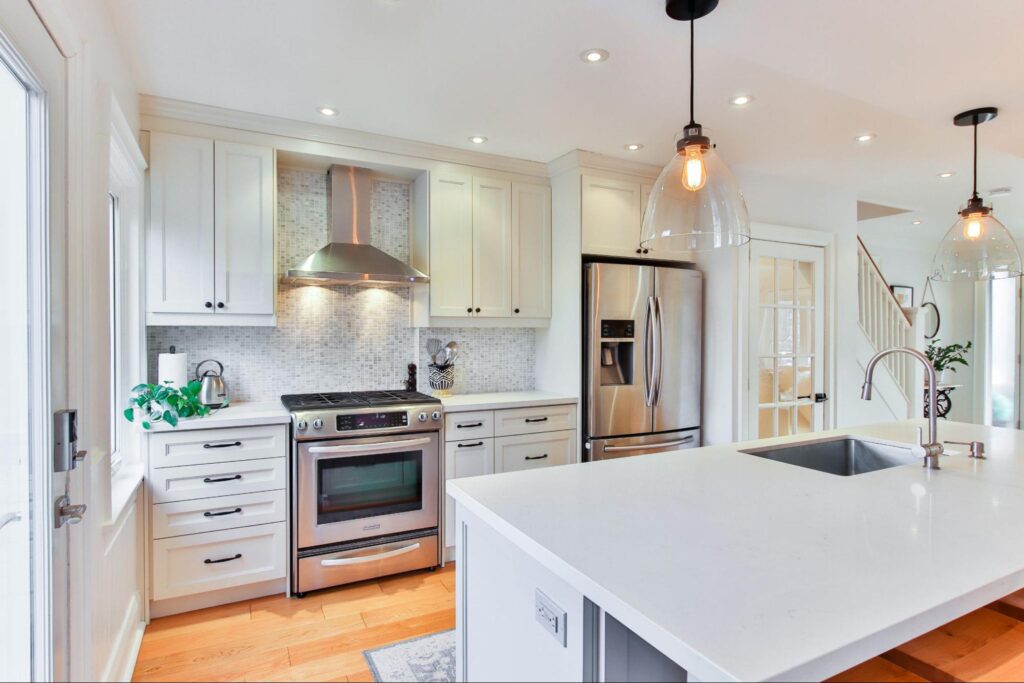
Most people think that large kitchens are easier to design and maintain. They have ample storage space, everything is organized, there’s no clutter on the countertops. However, there are challenges to this design.
Cabinets vs. open storage
Large kitchens offer the luxury of having a lot of storage. Most people decide on cabinets on every wall, but that can be really boring in some instances.
If you have a large kitchen and want to add a focal point, you can do that easily with open shelving or storage. Adding shelves to display your spices, for example, can be really pleasing to the eye. It also makes the room cosier and lived-in.
Workflow
The main thing that homeowners with a large kitchen struggle with is the workflow of the space. When you have a big kitchen, you have to take more steps to use it.
Proper appliance placement can achieve a better workflow. Again, follow the rule of the triangle that we spoke of earlier.
Making the space feel like home
Large kitchens are easier to use, there’s no doubt about that. But they can feel as if nobody uses them. When everything has its place, it’s well organised and de-cluttered, the space can be overwhelmingly empty.
Consider the proper accessories to add to a large kitchen. Creating different focal points in the space creates interest and immediately adds character. It’s also a wonderful way to express yourself as a person.
Cost-effectiveness
When remodelling your home, large kitchens can be extremely expensive. You have a lot of cabinets, a lot of countertops and appliances to think of. This can really impact the overall budget of the renovation and you have to be prepared for that.
One good way to design your large kitchen and save some money is by not doing everything all at once.
You can divide the project into two parts – the first one consisting of the main aspects of the kitchen (basic cabinetry, countertop spaces and appliances) and the second as add-ons (more cabinets, an island, open-shelving, etc.). That way, you can save money.
Maintenance
Maintenance is one huge problem of bigger kitchens. Yes, the space can be decluttered, but you still have to clean it. Having a large kitchen can result in more time for cleaning and maintenance.
How to Optimize the Kitchen Storage Area
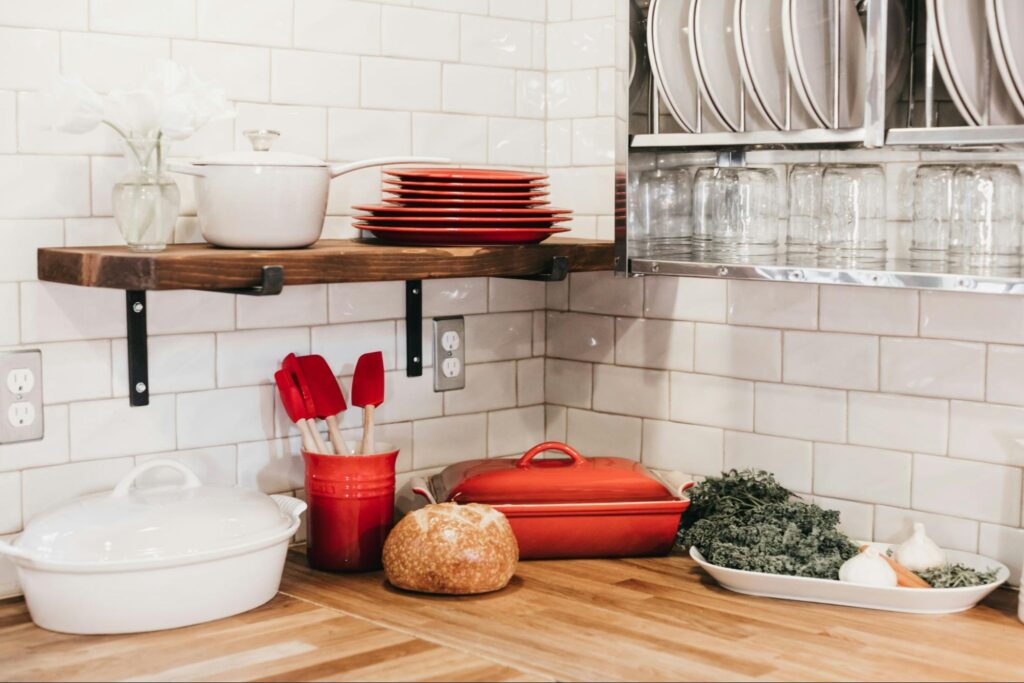
Storage is one of the main aspects that makes a kitchen usable. It influences the workflow, helps with decluttering and it can be a great design element all at once.
There are a lot of ways to optimise the storage space in your kitchen. Here are some kitchen storage ideas:
- Include adjustable shelving – the shelves in your kitchen can be adjustable so you can fit every odd-shaped object nicely. This way, you can customise the storage to your preference and change it anytime.
- Invest time and budget in the organisation – using different add-ins in your cabinets and drawers can help with the organisation of the space. This also improves the workflow, as you will know exactly where everything is.
- Hide the appliances – if you have enough closed storage space, consider giving up a cabinet for appliances such as toasters, multi-cookers, blenders, etc. These can make the space feel cluttered if left on the countertops.
- Use every space possible – you have to think how to use every nook and cranny in the kitchen for storage. For example, if you have a dining area, you can choose a bench for sitting rather than chairs. That way you can use the extra storage in the bench.
- Keep it organized – declutter your kitchen daily, don’t leave unnecessary appliances on the countertops. Use labels and different organization techniques to make the process easier. Always clean-up after cooking.
As you can see, there are a lot of ways you can design your dream kitchen.
It doesn’t matter if the space is large or small, traditional or modern in design – the kitchen serves a function like no other. It’s a place where everyone gathers, cooks delicious food and hangs out. Making it feel as cozy and as usable will go a long way. And if you need them – you can always hire a professional interior designer.
Frequently Asked Questions:
What is a kitchen triangle?
The kitchen triangle is the strategic placement of the most used appliances in the space – the sink, the fridge and the stove. Placing them in a triangle can lead to better workflow of the space.
How can I optimise the storage space in a small kitchen?
You can extend the cabinets top the ceiling of the room and that way you will have additional storage without making the space feel even more cramped.
Can I paint a small kitchen dark green?
Yes you can, but the whole colour palette of the space has to revolve around green to make it feel bigger.

